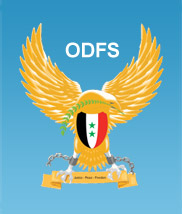Ribal Al Assad condemns U.S. Military proposal to Arm Rebels in Syria
Thursday, 13 June 2013
U.S. Military Proposal to Arm Rebels Includes No-Fly Zone in Syria
Wall Street Journal
JUNE 13, 2013
A U.S. military proposal for arming Syrian rebels also calls for a limited no-fly zone inside Syria that would be enforced from Jordanian territory to protect Syrian refugees and rebels who would train there, according to U.S. officials.
Asked by the White House to develop options for Syria, military planners have said that creating an area to train and equip rebel forces would require keeping Syrian aircraft well away from the Jordanian border.
To do that, the military envisages creating a no-fly zone stretching up to 25 miles into Syria which would be enforced using aircraft flown from Jordanian bases and flying inside the kingdom, according to U.S. officials.
The White House is currently considering proposals to arm the rebels in Jordan, according to U.S. officials. White House National Security Council spokeswoman Caitlin Hayden declined to comment on the details of those deliberations.
The limited no-fly zone wouldn't require the destruction of Syrian antiaircraft batteries, U.S. officials said.
Officials said the White House could decide to authorize the U.S. to arm and train rebels in Jordan without authorizing the no-fly zone recommended by military planners. A White House announcement could come soon, officials said.
Jordan has been inundated by a flood of refugees that Jordanian and U.S. officials say is a growing threat to the kingdom, a key U.S. ally in the region. The U.S. has already moved Patriot air defense batteries and F-16 fighter planes to Jordan, which could be integral to any no-fly zone if President Barack Obama approves the military proposal.
Proponents of the proposal say a no-fly zone could be imposed without a U.N. Security Council resolution, since the U.S. would not regularly enter Syrian airspace and wouldn't hold Syrian territory.
U.S. planes have air-to-air missiles that could destroy Syrian planes from long ranges. But officials said that aircraft may be required to enter Syrian air space if threatened by advancing Syrian planes. Such an incursion by the U.S., if it were to happen, could be justified as self-defense, officials say.
Military planners believe it would be dangerous to set up a major operation inside Jordan to arm the rebels without creating a no-fly zone to hold Syrian aircraft back.
"Unless you have a good buffer zone inside Syria, you risk too much," said a U.S. official briefed on the military proposal.
Creating even a limited buffer zone that Syrian airplanes cannot enter will be expensive, costing an estimated $50 million a day. Still, officials say that a full no-fly zone covering all of Syria would cost far more money. Officials said the U.S. hopes the operation would be conducted with other allies, who could help pay for the cost of a no-fly zone.
The U.S. planes involved in the no-fly zone would fly from Jordan and possibly from Navy ships in the Mediterranean or Red Sea. Jordan has offered the U.S. and its allies the use of its military bases to protect a safe zone inside the kingdom, according to U.S. officials. Jordanian officials in Washington had no immediate comment.
U.S. military officials believe it will take about a month to get such a limited no fly zone up and running, officials say. Officials say there may be a limited window to do so. If Russia decides to provide advanced, long-range S-300 air defense weapons to Syria, it would make such a limited no-fly zone far more risky for U.S. pilots.
Responding to the announcement, Director of ODFS, Ribal Al-Assad said:
“The international community should be working towards bringing the conflict in Syria to an end not stoking fires further. We have already seen 100,000 deaths and all parties should be working towards a peaceful solution and not a further militarisation of a conflict.
If this proposal goes forward we would also see the knock on effect of an arms race between parties supporting both sides; not only would this have terrible consequences for Syria but the whole region in general.
The International Community has to understand that there is no military solution to the conflict, it is time to call for all foreign fighters on both sides to withdraw from Syria. We need to work towards a peaceful solution through dialogue if we are to prevent the situation from deteriorating further.”

